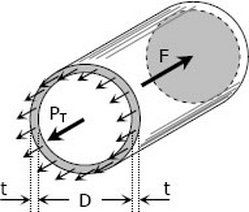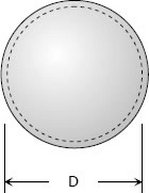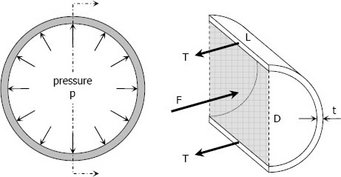Thin-walled Pressure Vessels
a Tank or pipe carrying a fluid or gas under a pressure is subjected to tensile forces, which resist bursting, developed across longitudinal and transverse sections.
TANGENTIAL STRESS, σt (Hoop Stress)
Consider the tank shown being subjected to an internal pressure . The length of the tank is and the wall thickness is . Isolating the right half of the tank:
a Tank or pipe carrying a fluid or gas under a pressure is subjected to tensile forces, which resist bursting, developed across longitudinal and transverse sections.
TANGENTIAL STRESS, σt (Hoop Stress)
Consider the tank shown being subjected to an internal pressure . The length of the tank is and the wall thickness is . Isolating the right half of the tank:
The forces acting are the total pressures caused by the internal pressure and the total tension in the walls .
F=PA=P*D*L
T=σttL
σh=PD/2t
If there exist an external pressure and an internal pressure , the formula may be expressed as:
σh=(Pi-Po)D/2t
F=PA=P*D*L
T=σttL
σh=PD/2t
If there exist an external pressure and an internal pressure , the formula may be expressed as:
σh=(Pi-Po)D/2t
LONGITUDINAL STRESS

Consider the free body diagram in the transverse section of the tank:
The total force acting at the rear of the tank must equal to the total longitudinal stress on the wall . Since is so small compared to , the area of the wall is close to PiDt
And Therefore σt=PD/4t
If there exist an external pressure and an internal pressure , the formula may be expressed as:
σt=(Po-Pi)D/4t
From This it can be easily observed that the tangential stress ( Hoop ) is twice the longitudinal stress .
σh = 2 σt
The total force acting at the rear of the tank must equal to the total longitudinal stress on the wall . Since is so small compared to , the area of the wall is close to PiDt
And Therefore σt=PD/4t
If there exist an external pressure and an internal pressure , the formula may be expressed as:
σt=(Po-Pi)D/4t
From This it can be easily observed that the tangential stress ( Hoop ) is twice the longitudinal stress .
σh = 2 σt
Spherical Shell :

If a spherical tank of diameter and thickness contains gas under a pressure of , the stress at the wall can be expressed as:
σt=(D/Po-Pi)4t
σt=(D/Po-Pi)4t

